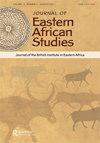Refugees in uniform: community policing as a technology of government in Kakuma refugee camp, Kenya
IF 0.6
3区 社会学
Q2 AREA STUDIES
引用次数: 9
Abstract
ABSTRACT Community policing has been a popular paradigm for local anti-crime activities in Africa since the 1990s and spread rapidly across the continent. Humanitarian agencies have increasingly embraced versions of the framework to administer refugee camps and ostensibly foster security, protection and peaceful co-existence among residents. This article demonstrates that the deployment of community policing in Kakuma camp in north-western Kenya has been far more contested. Aid organisations and Kenyan authorities have competed in determining the orientation and implementation of community policing at a time when the government was intensifying both securitisation of refugees and counter-terrorism measures. Kakuma‘s Community Peace and Protection Teams (CPPTs) were therefore torn between humanitarian conceptions of localised refugee protection and more illiberal forms of security work which bound them closer to the Kenyan state. The permanent negotiation between these parallel ‘technologies of government' was reflected in contestations over uniforms, trainings and everyday practices. Powerful institutions attempted to script refugee conduct and thus discipline the camp's pluralistic social networks and forms of counter-organisation embedded in a ‘deep community’. Based on ethnographic fieldwork, the article illustrates that governing refugees through community policing blurs the lines between humanitarian protection, domesticating local systems of governance, and expanding the security state.身着制服的难民:肯尼亚卡库马难民营的社区警务技术
自20世纪90年代以来,社区警务一直是非洲地方反犯罪活动的一种流行模式,并在非洲大陆迅速蔓延。人道主义机构越来越多地采用了各种形式的框架来管理难民营,表面上促进居民之间的安全、保护和和平共处。这篇文章表明,在肯尼亚西北部的卡库马营地部署社区警察的争议要大得多。在政府加强难民安全与反恐措施之际,援助组织和肯尼亚当局在确定社区警务的方向和实施方面展开了竞争。因此,卡库马的社区和平与保护小组(cppt)在人道主义的地方难民保护概念和更狭隘的安全工作形式之间左右为难,后者将他们与肯尼亚政府联系得更紧密。这些平行的“政府技术”之间的长期谈判反映在对制服、培训和日常实践的争论中。强大的机构试图规范难民的行为,从而约束难民营的多元社会网络和嵌入“深层社区”的反组织形式。基于民族志的田野调查,本文说明了通过社区警务管理难民模糊了人道主义保护、驯化地方治理系统和扩大安全状态之间的界限。
本文章由计算机程序翻译,如有差异,请以英文原文为准。
求助全文
约1分钟内获得全文
求助全文
来源期刊

Journal of Eastern African Studies
AREA STUDIES-
CiteScore
3.30
自引率
7.10%
发文量
12
期刊介绍:
Journal of Eastern African Studies is an international publication of the British Institute in Eastern Africa, published four times each year. It aims to promote fresh scholarly enquiry on the region from within the humanities and the social sciences, and to encourage work that communicates across disciplinary boundaries. It seeks to foster inter-disciplinary analysis, strong comparative perspectives, and research employing the most significant theoretical or methodological approaches for the region.
 求助内容:
求助内容: 应助结果提醒方式:
应助结果提醒方式:


